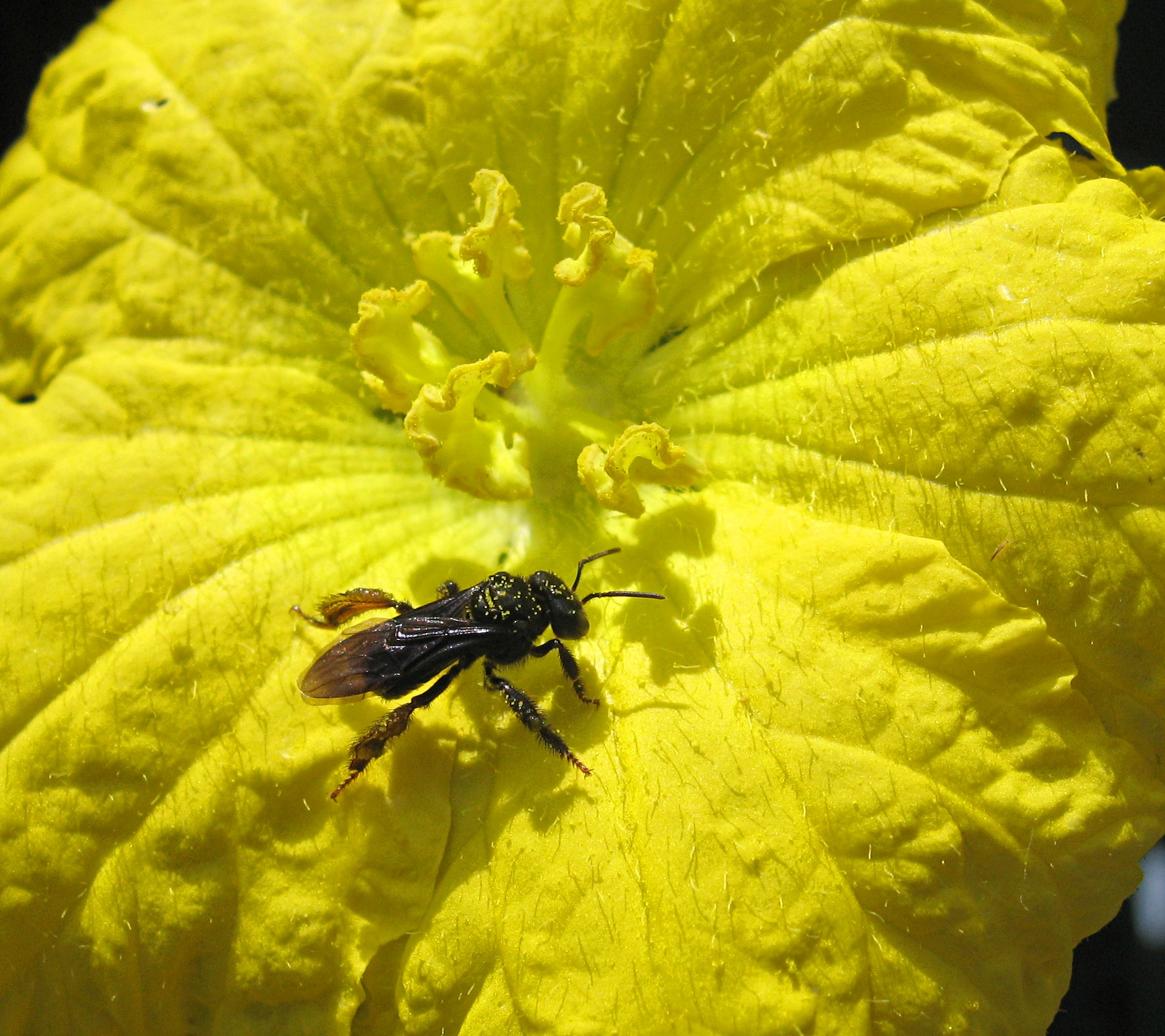
Unidentified Meliponini bee, covered with pollen, visiting a flower of the Vegetable Sponge Gourd (Luffa cylindrica) in Campinas, Brazil (Wikimedia Commons/Leonardo Ré-Jorge/Own work, CC BY-SA 4.0)
Editor's note: This story originally appeared on ClimateTracker.org and is republished here as part of Covering Climate Now, a global journalism collaboration strengthening coverage of the climate story.
Seeing her stingless bees stressed every season keeps Regina Heredia, a beekeeper and organic honey producer, out of her sleep. As heatwaves become more frequent, droughts last longer and blossoming time changes on trees, stingless bees, or "señoritas" (young lady in Spanish) are having a hard time to adapt to climate change and other human-driven environmental changes.
There are over a hundred varieties of stingless bees in Bolivia. They are responsible for the pollination of more than 70% of the country's trees. Numbers say that more than 80% of the 250 thousand plants known with flowers depend on pollination to continue their sexual reproduction so the life of whole ecosystems often depends on them thriving.
Some stingless bees are the only ones adapted to pollinate almond trees, chestnuts, and more crops than any other species. There is no other pollination agent that can replace them.
Javier Coimbra, a researcher and conservationist, explains that stingless bees have an amazing capability to adapt. They can take nectar and pollen from any flower, as opposed to their European cousins, Apis melleris, which favor big flowers with a lot of nectar. The Bolivian stingless bee's honey is richer in minerals and other medicinal properties.

Stingless bees at risk
Bolivia suffered from extreme wildfires in 2019 and 2020. The climate change-driven drought strengthened the fires and, in the past two years, over 5 million hectares were lost in the country, 3.5 million of them in Santa Cruz department.
So far, the aftermath for bees is still under study. "There's preliminary data on the affected mammals and vegetation, but with stingless bees and other pollinators we can't tell a number yet," says Coimbra. However, the conditions after the fires forebode a negative panorama for these valuable species and their ecosystems: without flowers, they have to fly further, the colonies are abandoned, and larger areas are left behind without pollinators, reducing the chances of the forest to regenerate.
The expansion of farmlands and pastures, and the increased use of pesticides, is impacting the bees more than ever. "When they [the landowners] chop down trees to create more farmlands, they attack the hives and burn them to clear the land, they just take the honey," says Regina. "We have to move the hives deeper and deeper further and further into the deeper forest, or we won't be able to control the effects of these elements on bees and honey."

A mural is seen in Santa Cruz de la Sierra, Bolivia (Flickr/Andrew Campbell)
An opportunity in the big city
José Carlos Becker, an enthusiast beekeeper, is taking an action. To improve the situation, he promotes the installation of stingless beehives and honey production in the city of Santa Cruz de la Sierra, one of South America's fastest-growing cities. A UNDP report established that it grows at 6,5%, while the rest of the cities in the country kept a rate of 5% growth. The city's breakneck development has been taking land, putting down trees, and turning more than 150 species that grow in the city into a lawn, leaving stingless bees without trees or vegetation.
"People take them first as pets, but as they interact they fall in love and are more aware of how valuable and vulnerable they are," says. With over 200 colonies installed in Santa Cruz, José feels that he's bringing them back where they belong.
"People don't imagine how important bees are. With the new land use approved by INRA [National Institute of Agriculture Reforms] landowners just care to produce monocultures and put trees down. This can be an opportunity to teach and raise awareness on bees. If you see a mango tree in the city, without the bees, it will produce only 1 or 2 fruits. That's how much we depend on them," says. His statement matches with the FAO report that without pollinators the fruits tend to be smaller or the production will be deficient.
So far, all of the hives continue to live and adapt to their life in the city, protected in balconies and gardens, or hiding between bricks or a tree on a square. They are companions for those who are growing an edible garden or are looking to produce some honey for self-consumption. José saves beehives from fallen trees and finds them a new home. He assures that stingless bees are resilient, but abrupt weather changes, like heavy rain, affects them.
PRECIS (Providing Regional Climates for Impacts Studies) Climate Model for Bolivia indicates that precipitation will intensify and become more frequent for December, January, and February, projecting a 53% increase in heavy rains by 2100.
"[The bees] are only 2 to 5 mm long, so imagine a sudden heavy rain in the city as they are still out looking for nectar, it is impossible for them to come back to their hive, they die out there," says Becker.
Like Jose Becker, Regina Heredia's hope is on people. She believes that the presence of stingless bees in urban areas is the best way to raise awareness on both these important insects and climate change, removing the misconception that all bees have stings and are dangerous, and proving that mankind and bees are more linked than we often believe. Programs of handling and conservation are needed more than ever, she says, as is the implementation of climate change mitigation policies by the governments to save more than bees.
Advertisement







